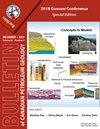通过对纽芬兰西部近海海洋数据集的垂直整合,对圣乔治湾基岩和第四纪地质有了新的认识
Q3 Earth and Planetary Sciences
引用次数: 5
摘要
圣乔治湾位于加拿大纽芬兰西海岸港港半岛以南。石炭纪海湾圣乔治次盆地延伸到海湾下方和东南岸。该次盆地是Magdalen盆地的延伸,Magdalen盆地是一个石炭纪盆地,具有潜在的资源潜力,是更广泛的Maritimes盆地的一部分。该次盆地的陆上地质情况相对较好。来自不太为人所知的海上部分的海洋数据集包括高分辨率测深数据、航磁数据、浅层井和工业井,以及浅层和深层(常规)二维地震数据。在圣乔治湾内表层覆盖较厚的地区,已有第四纪特征的记载。在海湾的外部,基岩脊被冰山搅动的冰川海洋泥和冰碛覆盖。在这层盖下,重新解释的A-36井孢粉分析只反映了Visean Codroy群。该井最上层Codroy群可能与附近浅海基岩岩心的红砂岩有关;然而,更年轻的石炭纪岩石也可能存在。使用常规地震数据绘制的反射器标记了Codroy组的底部和Codroy组中盐单元的顶部。盐核背斜和向斜与盐运动有关,并与一个具有倾滑和右滑成分的断裂系统有关。多波束测深和磁场的第二次垂直导数将褶皱描绘成曲线,雁梯队,在某些情况下,双陡降。在次盆地下方,地震和航磁资料显示元古代基底块体和早古生代罗曼尼斯溪断裂的近海伸展。石炭系构造显示了右旋张拉的环境,该环境使早古生代构造重新激活,与先前的基底弱点一致。本文章由计算机程序翻译,如有差异,请以英文原文为准。
New insights into the Bedrock and Quaternary Geology of St. George’s Bay from a vertical integration of marine datasets, offshore western Newfoundland
St. George’s Bay lies south of Port au Port Peninsula on the west coast of Newfoundland, Canada. The Carboniferous Bay St. George subbasin extends beneath the bay and onshore to the southeast. The subbasin is an extension of the Magdalen Basin, a Carboniferous basin with probable resource potential, part of the broader Maritimes Basin. The onshore geology of the subbasin is relatively well understood. Marine datasets from the less well known offshore portion include high-resolution bathymetry, aeromagnetic data, shallow and industry wells, and both shallow and deeper (conventional) two-dimensional seismic data. Quaternary features were previously documented in inner St. George’s Bay where the surficial cover is thick. In the outer part of the bay, bedrock ridges are draped by iceberg-turbated glaciomarine mud and moraines. Beneath this cover, reinterpreted palynological analyses in the A-36 well reflect only Visean Codroy Group. The uppermost Codroy Group of this well may correlate with nearby red sandstones from shallow marine bedrock drill cores; however, younger Carboniferous rocks may also be present. Reflectors mapped using conventional seismic data mark the base Codroy Group and the top of a salt unit in the Codroy Group. Salt-cored anticlines and synclines are associated with halokinesis, and with a fault system with both dip-slip and dextral-slip components. Multibeam bathymetry and the second vertical derivative of the magnetic field delineate the folds as curvilinear, en echelon, and, in some cases, doubly plunging. Beneath the subbasin, seismic and aeromagnetic data indicate Proterozoic basement blocks and an offshore extension of the early Paleozoic Romaines Brook Fault. The Carboniferous structures suggest an environment of dextral transtension that reactivated early Paleozoic structures aligned with pre-existing weaknesses in basement.
求助全文
通过发布文献求助,成功后即可免费获取论文全文。
去求助
来源期刊

Bullentin of Canadian Petroleum Geology
Earth and Planetary Sciences-Geochemistry and Petrology
CiteScore
2.50
自引率
0.00%
发文量
0
期刊介绍:
The Bulletin of Canadian Petroleum Geology is a peer-reviewed scientific journal published four times a year. Founded in 1953, the BCPG aims to be the journal of record for papers dealing with all aspects of petroleum geology, broadly conceived, with a particularly (though not exclusively) Canadian focus. International submissions are encouraged, especially where a connection can be made to Canadian examples.
 求助内容:
求助内容: 应助结果提醒方式:
应助结果提醒方式:


